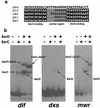Complete nucleotide sequence of Klebsiella pneumoniae multiresistance plasmid pJHCMW1
- PMID: 12384346
- PMCID: PMC128720
- DOI: 10.1128/AAC.46.11.3422-3427.2002
Complete nucleotide sequence of Klebsiella pneumoniae multiresistance plasmid pJHCMW1
Abstract
The multiresistance plasmid pJHCMW1, harbored by a clinical Klebsiella pneumoniae strain isolated from a neonate with meningitis, was sequenced. A circular sequence of 11,354 bp was generated, of which 7,993 bp make up Tn1331, a transposon including the antibiotic resistance genes aac(6')-Ib, aadA1, bla(OXA-9), and bla(TEM-1). The gene aac(6')-Ib is included in a gene cassette, and both aadA1 and bla(OXA-9) are included in a single-gene cassette that may have arisen as a consequence of a recombination event involving two integrons. The pJHCMW1 plasmid replicates through a ColE1-like RNA-regulated mechanism, includes a functional oriT, and two loci with similarity to XerCD site-specific recombination target sites involved in plasmid stabilization by the resolution of multimers. One of these two loci, mwr, is active and has been the subject of previous studies, and the other, dxs, is not functional but binds the recombinase XerD with low affinity. Two additional open reading frames were identified, one with low similarity to two hypothetical membrane proteins from Mycobacterium tuberculosis and Mycobacterium leprae and the other with low similarity to psiB, a gene encoding a function that facilitates the establishment of the transferring plasmid in the recipient bacterial cell during the process of conjugation.
Figures





Similar articles
-
Stability by multimer resolution of pJHCMW1 is due to the Tn1331 resolvase and not to the Escherichia coli Xer system.Microbiology (Reading). 2000 Mar;146 ( Pt 3):581-589. doi: 10.1099/00221287-146-3-581. Microbiology (Reading). 2000. PMID: 10746761
-
Transfer of an Escherichia coli ST131 multiresistance cassette has created a Klebsiella pneumoniae-specific plasmid associated with a major nosocomial outbreak.J Antimicrob Chemother. 2012 Jan;67(1):74-83. doi: 10.1093/jac/dkr405. Epub 2011 Oct 11. J Antimicrob Chemother. 2012. PMID: 21990049
-
Complete nucleotide sequence of pKP96, a 67 850 bp multiresistance plasmid encoding qnrA1, aac(6')-Ib-cr and blaCTX-M-24 from Klebsiella pneumoniae.J Antimicrob Chemother. 2008 Dec;62(6):1252-6. doi: 10.1093/jac/dkn397. Epub 2008 Sep 23. J Antimicrob Chemother. 2008. PMID: 18812424
-
Sequencing and expression of aadA, bla, and tnpR from the multiresistance transposon Tn1331.Plasmid. 1990 Nov;24(3):218-26. doi: 10.1016/0147-619x(90)90005-w. Plasmid. 1990. PMID: 1963948
-
Klebsiella pneumoniae multiresistance plasmid pMET1: similarity with the Yersinia pestis plasmid pCRY and integrative conjugative elements.PLoS One. 2008 Mar 19;3(3):e1800. doi: 10.1371/journal.pone.0001800. PLoS One. 2008. PMID: 18350140 Free PMC article.
Cited by
-
Sequencing and genetic variation of multidrug resistance plasmids in Klebsiella pneumoniae.PLoS One. 2010 Apr 12;5(4):e10141. doi: 10.1371/journal.pone.0010141. PLoS One. 2010. PMID: 20405037 Free PMC article.
-
Identification of an Inhibitor of the Aminoglycoside 6'-N-Acetyltransferase type Ib [AAC(6')-Ib] by Glide Molecular Docking.Medchemcomm. 2016 Jan 1;7(1):184-189. doi: 10.1039/C5MD00316D. Epub 2015 Nov 3. Medchemcomm. 2016. PMID: 26973774 Free PMC article.
-
External guide sequences targeting the aac(6')-Ib mRNA induce inhibition of amikacin resistance.Antimicrob Agents Chemother. 2007 Jun;51(6):1918-25. doi: 10.1128/AAC.01500-06. Epub 2007 Mar 26. Antimicrob Agents Chemother. 2007. PMID: 17387154 Free PMC article.
-
pKBuS13, a KPC-2-encoding plasmid from Klebsiella pneumoniae sequence type 833, carrying Tn4401b inserted into an Xer site-specific recombination locus.Antimicrob Agents Chemother. 2015 Sep;59(9):5226-31. doi: 10.1128/AAC.04543-14. Epub 2015 Jun 15. Antimicrob Agents Chemother. 2015. PMID: 26077252 Free PMC article.
-
Plasmid-Mediated Antibiotic Resistance and Virulence in Gram-negatives: the Klebsiella pneumoniae Paradigm.Microbiol Spectr. 2014;2(5):1-15. doi: 10.1128/microbiolspec.PLAS-0016-2013. Microbiol Spectr. 2014. PMID: 25705573 Free PMC article.
References
-
- Barre, F., and D. J. Sherratt. 2002. Xer site-specific recombination: promoting chromosome segregation, p. 145-161. In N. Craig, R. Craigie, M. Gellert, and A. Lambowitz (ed.), Mobile DNA II. ASM Press, Washington, D.C.
-
- Bates, S., R. A. Roscoe, N. J. Althorpe, W. J. Brammar, and B. M. Wilkins. 1999. Expression of leading region genes on IncI1 plasmid ColIb-P9: genetic evidence for single-stranded DNA transcription. Microbiology 145:2655-2662. - PubMed
-
- Casin, I., F. Bordon, P. Bertin, A. Coutrot, I. Podglajen, R. Brasseur, and E. Collatz. 1998. Aminoglycoside 6′-N-acetyltransferase variants of the Ib type with altered substrate profile in clinical isolates of Enterobacter cloacae and Citrobacter freundii. Antimicrob. Agents Chemother. 42:209-215. - PMC - PubMed
-
- Cole, S. T., K. Eiglmeier, J. Parkhill, K. D. James, N. R. Thomson, P. R. Wheeler, N. Honore, T. Garnier, C. Churcher, D. Harris, K. Mungall, D. Basham, D. Brown, T. Chillingworth, R. Connor, R. M. Davies, K. Devlin, S. Duthoy, T. Feltwell, A. Fraser, N. Hamlin, S. Holroyd, T. Hornsby, K. Jagels, C. Lacroix, J. Maclean, S. Moule, L. Murphy, K. Oliver, M. A. Quail, M. A. Rajandream, K. M. Rutherford, S. Rutter, K. Seeger, S. Simon, M. Simmonds, J. Skelton, R. Squares, S. Squares, K. Stevens, K. Taylor, S. Whitehead, J. R. Woodward, and B. G. Barrell. 2001. Massive gene decay in the leprosy bacillus. Nature 409:1007-1011. - PubMed
-
- Coque, T. M., A. Oliver, J. C. Perez-Diaz, F. Baquero, and R. Canton. 2002. Genes encoding TEM-4, SHV-2, and CTX-M-10 extended-spectrum β-lactamases are carried by multiple Klebsiella pneumoniae clones in a single hospital (Madrid, 1989 to 2000). Antimicrob. Agents Chemother. 46:500-510. - PMC - PubMed
Publication types
MeSH terms
Substances
Grants and funding
LinkOut - more resources
Full Text Sources

